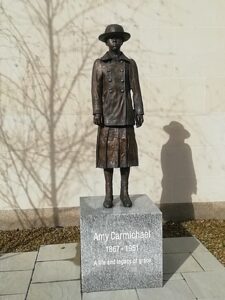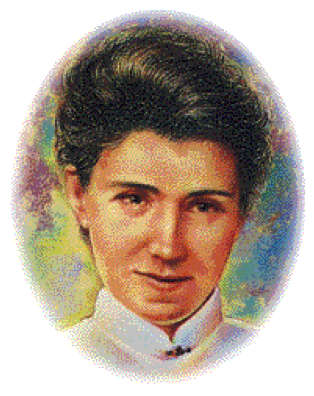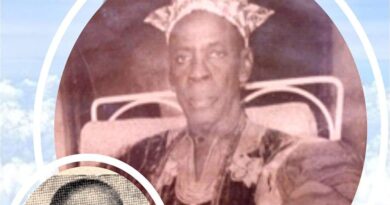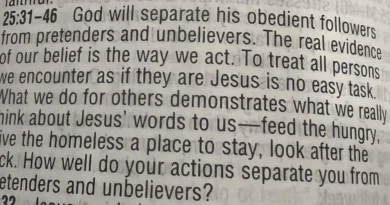Amy Carmichael: The Life & Work of A blessed Missionary
AMY CARMICHAEL: A Life of Devotion and Compassion.
What makes a life of faith truly extraordinary?
According to Sarah Edwards, “the best and greatest legacy we can leave is not what we do, but who we raise.”
The impact we make in this world makes us. In a world filled with agony and pain; the cry of children flows like blood into the river for safety. Boys and girls were deprived of love and care and put on the altar of injustice to be butchered by pain. then came a deliverer who fought for justice, and wipe away the tears of children and adults alike. Amy Carmichael transforms the depths of Indian poverty into the heights of spiritual devotion.
Early life and her call to mission.
Amy Beatrice Carmichael was born in 1867 in the small town of Millisle into a well-to-do North Irish Christian family. She was born to David and Catherine Carmichael; and was the oldest of seven children. She attended Wesleyan Methodist boarding school. At age 13, while still in school, she accepted Christ as her saviour. When she was 18, her father died of pneumonia, leaving the family in a difficult financial calamity.
After the death of her father, the family moved to Belfast. There, she began to visit slums and seeing the terrible conditions under which many women and girls worked in the factories.

She began her ministry with the women, where she became acquainted with the Keswick Movement. This was where she grew to meet Mr. Wilson, a widower, who asked her to live in his home and be his secretary. She became so acquainted with Mr. Wilson that she learned so much about his knowledge and love for God.
She developed great work among the women in Belfast and was asked to raise a similar ministry in Manchester. There, with her mother at her side, she raised a ministry among slum people, particularly the women and girls who were working under terrible conditions in the factories.
Miss Amy received her Macedonian call in 1892 at the age of 24 and was also appointed as the first appointee of Keswick’s missions committee; then she went to Japan.
Mission Work in Japan
In the year 1893, Amy Carmichael left for Japan with her labourer, Misakisan to begin life as a missionary. She went to Japan but was met with disappointment. The Japanese language seemed impossible and the missionary community was not at peace as she had envisioned. After 15 months as a missionary, Amy became convinced that Japan was not where God sent her, and she also developed a health challenge, which also added to her leaving. Without notifying the Keswick Convention, she sailed for Ceylon. She was there for a few months before she went back to England. After a year in England, she returned to the field, but this time to in India.
Journey to India
In March 1901, A seven-year-old Indian girl named Preena escaped a Hindu temple where she had been abandoned by her mother as a “devotion to the goods.”.
A century before Amy Carmichael arrived in India, William Carey was the door to all missionaries in the country, translating the Bible into more than 15 languages and sharing the gospel with people from all social and economic classes.

Amy Carmichael arrived in Bangalore but later found out that she did not fit in with the existing missionary community, whereby she wrote decisively.
“Onward Christian Soldiers,
Sitting on the mats,
Nice, warm, and cosy
Like pussycats.”
A missionary couple, Thomas and Catherine Walker, invited her to work with them in Tirunelveli, a city in southern India, where she lived for over a decade. The couple had an itinerant ministry, travelling to villages, towns, and cities on foot or by ox cart. With the couple’s assistance, Amy was able to learn the local language, “Tamil.” She was able to understand now why God never answered her prayer when she was a toddler.
She prayed, “Lord, give me a blue eye; I will praise you.” She prayed for all her life, but she felt God never listen. Seeing the Indian brown hair and eyes made her realise God knows best. With her brown hair and eyes, she felt like a family with the Indians.
During her travels with the Walkers, Carmichael encountered a temple woman who was “married” to the gods. She discovered that the woman was a prostitute who spent her life in sexual service to the priests and worshippers in Hindu temples. She realised poor families often sell their children to the temple, where they become sex slaves.
“The discovery of this system was like a sword in Amy’s missionary soul,” which was later scripted by Elizabeth Elliot in her biography in a book titled “A Chance to Die.” Miss Amy was furious and said to herself that something needed to be done.
In the 1980s, Butler revealed the full extent of her knowledge of the white slave trade. Following this, she started her campaign against the trafficking and prostitution of girls and women in Europe. Carmichael was able to write with particular confidence in two short articles of 1906, published in the CEZMS periodical Indian Children and China’s Daughters.
Her book roused anger among pro-independence groups; it was denounced as being untruthful and inaccurate by Mahatma Gandhi and burned in India and New York.
There were a lot of allegations, objections, criticism, and condemnation towards her; she was castigated and rejected, and critics suggested that she could not understand their system because she was not part of the culture.
Against all allegations, criticism, and objections, her endeavour made a lasting impact in India; the minimum age for marriage was raised to fourteen for girls and eighteen for boys after the publication of her book.
READ: Empowering The Poor: Unbound’s Journey From 1981 To Today
Dohnavur Fellowship and Ministry
In March 1901, Carmichael had moved her mission to a compound covering an area of about 170 acres in Dohnaur, a village about fifteen miles south. This became her mission’s permanent residence, where housing, schooling, and medical services were provided for the protection and nurturing of vulnerable children.
She insisted the fellowship was more about being a family than an orphanage home. They are called the Tamil family, speak the Indian language, and wear “sari” instead of European clothes.
One day, a girl named Preena escaped from the Hindu temple and asked to be taken to Carmichael. From that day on, she became “Anma”‘s mother.
Amy finally settled down at the Dohnavur Fellowship, a sanctuary for abandoned and abused children with Carmichael as their full-time carer. Thousands of children received education and health care and learned to worship, work, and play together.
Carmichael never took furlough or returned home to Ireland, even after dislocating her ankle and breaking her leg. As Elliott wrote, the incident happened the same day the missionary had prayed, “Do anything, Lord, that will fit me to serve Thee and help my beloved.”
Carmichael was left with limited physical strength and was bedridden for the last two decades of her life. But she never stopped ministry just because of her health challenge and disability to walk; instead, she continued to minister by penning words of encouragement, authoring 35 books during her lifetime.
After serving in India for 55 years, Amy Carmichael died on January 18th, 1951. Through her ministry, over 1,000 Indian children received an education, gained access to medical care, experienced the joy of belonging to a family, and heard the gospel’s good news.
One of the best-known and reputable missionaries of the 19th century was Amy Carmichael; her books and journey blessed countless lives.
Content Credit| Eunice Oke
Picture Credit |




